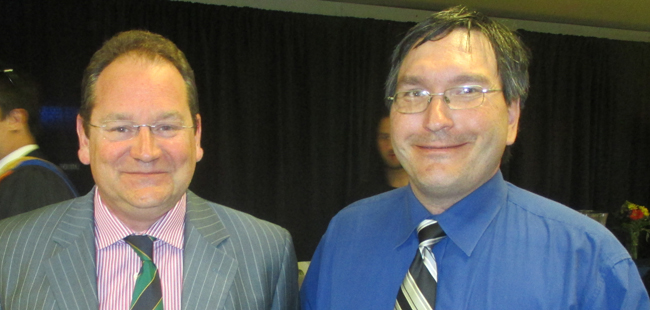Hot, cold and deep: Schafrik first Native to earn PhD in mining engineering

By Laura E. Young
SUDBURY – When Sidney Schafrik’s father asked him to choose the hardest subject to study that he could think of, Schafrik chose engineering.
And when Schafrik was doubting his choice at Laurentian University, his professor Laxman (Lucky) Amaratunga told him: “’First you suffer; then you prosper.’ That’s what got me through my second year of undergrad. (Engineering) is generally difficult and I came with the equivalent of a Grade 10 education,” Schafrik recalls.
While it wasn’t a breeze, ultimately Schafrik would prosper. In June, he capped five years of research to become the first Native person to earn a PhD in Natural Resources Engineering at Laurentian and arguably in all of Canada.
A member of the Chippewas of Rama First Nation near Orillia, Schafrik was also Laurentian’s first Native undergraduate in mining engineering in 2005. Working with Dean Millar as his supervisor, he completed his PhD work while based out of MIRARCO in Sudbury.
The formal title of his PhD – the use of packed sphere modelling for airflow and heat exchange analysis in broken or fragmented rock – essentially looks at how a mine works as a natural heat exchange system and how a mine is also able to use the Earth’s natural cooling for ventilation, especially as mines drive ever deeper to harvest resources?
“People have known for years that stored, cold air comes out of the rock. They just haven’t been able to realize how much and why. That’s what I was able to provide, a bit of an understanding of how it fundamentally works, versus just from observation.
“Because it gets cold in the winter and warms up in the summer, the time lag is what makes the cooling effect. It’s warmest in September. The actual system itself then cools down in the winter. In the summer cold air is still making its way through,” Schafrik says.
It means a mine can use the rock or the Earth to cool the mine instead of major artificial and mechanical refrigeration. “What this does is prevent the addition of more cooling, more artificial refrigeration systems to be able to deeper down and keep that mine alive.”
He kept his own studies alive as an undergraduate because he had the necessary support, he says.
He is honoured to be recognized as the first Native person to earn a mining engineering PhD and it shows that First Nations people can indeed reach such levels of academic and professional achievement when the assistance is there, he adds.
He took the support where he found it: from education programs at Rama and at Laurentian.
Mervin Dewasha provided co-op and mentorship opportunities to train during the summer through his undergraduate and master’s studies. Dean Millar supervised his PhD work at MIRARCO in Sudbury.
Schafrik is an engineering coordinator with Ontario Energy Matrix and is based at Rama. OEM works on renewable energy projects, in particular, with First Nations across Ontario.
His master’s thesis evaluated the social risks mining companies have when with First Nations reserves. The thesis provided a risk assessment strategy for impact-benefit agreements for mining companies so they would have at least a base indicator of the issues that arise when the two work together.
He looks ahead now to using the research and practical sides of his various degrees in Europe and on a major project with a First Nation in eastern Canada later this year.

